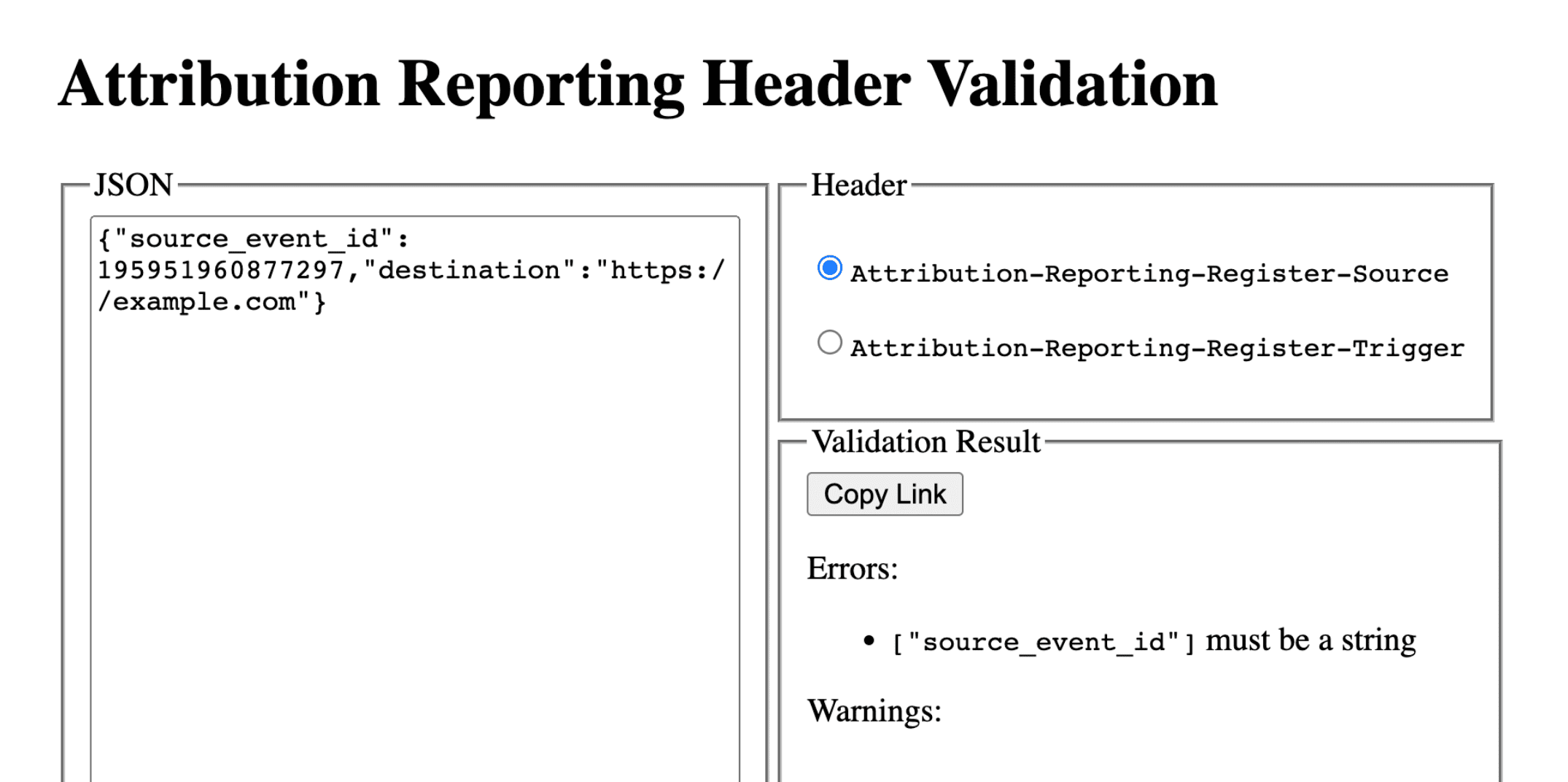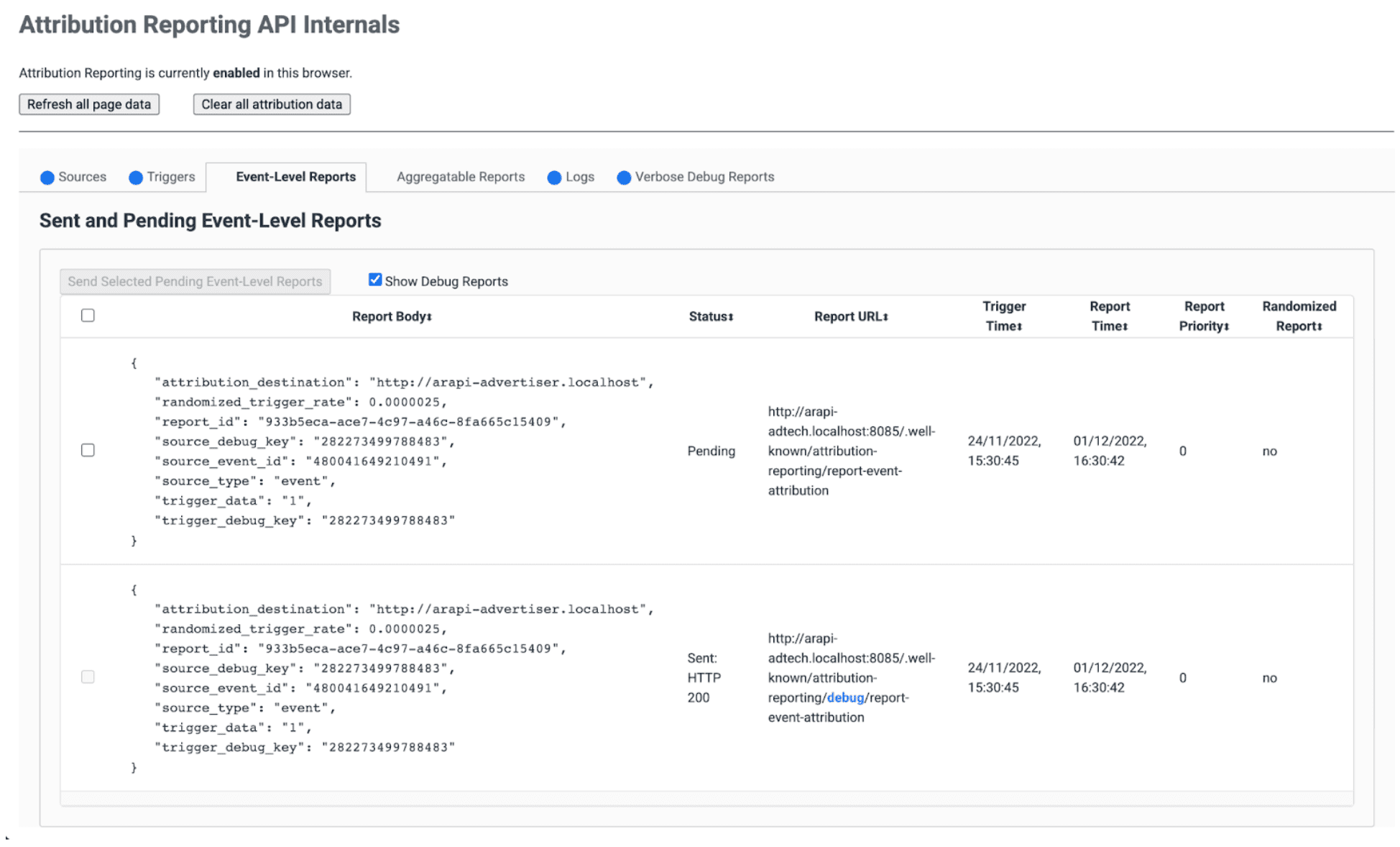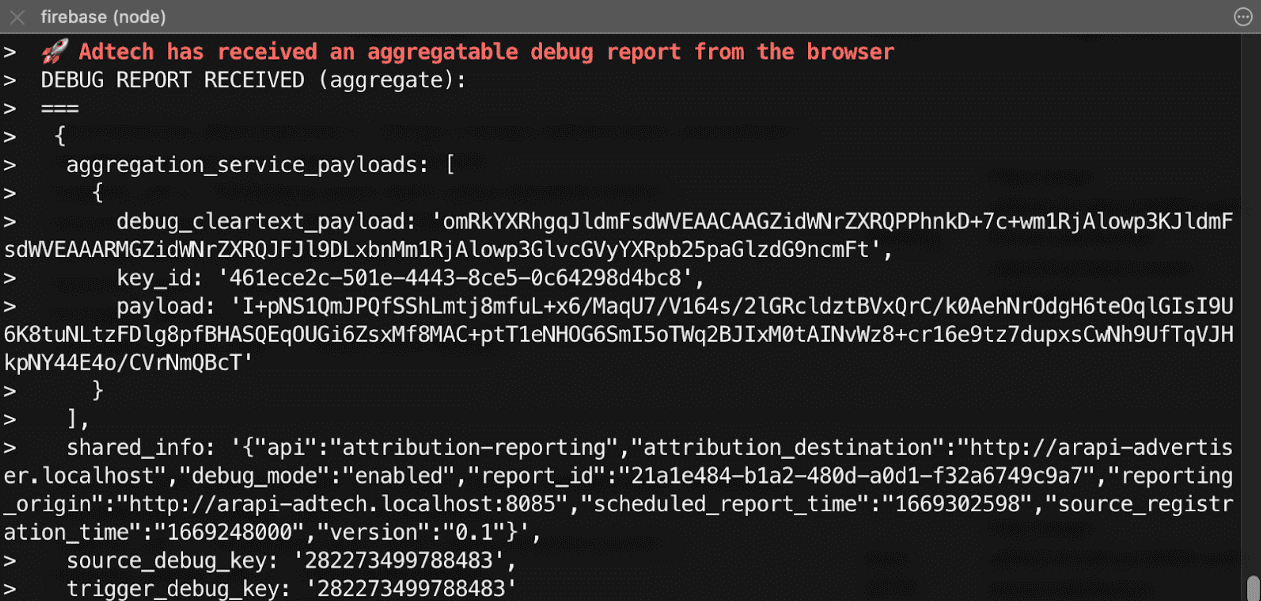第 2 部分 (共 3 部分),說明如何偵錯歸因報表。設定偵錯報表。
詞彙解釋
- The reporting origin is the origin
that sets the Attribution Reporting source and trigger headers.
All reports generated by the browser are sent to this origin. In this guidance,
we use
https://adtech.exampleas the example reporting origin. - An attribution report (report for short) is the final report (event-level or aggregatable) that contains the measurement data you've requested.
- A debug report contains additional data about an attribution report, or about a source or trigger event. Receiving a debug report does not necessarily mean that something is working incorrectly! There are two types of debug reports
- A transitional debug report is a debug report that requires a cookie to be set in order to be generated and sent. Transitional debug reports will be unavailable if a cookie is not set, and once third-party cookies are deprecated. All debug reports described in this guide are transitional debug reports.
- Success debug reports track successful generation of an attribution report. They relate directly to an attribution report. Success debug reports have been available since Chrome 101 (April 2022).
- Verbose debug reports can track missing reports and help you determine why
they're missing. They indicate cases where the browser did not record a source
or trigger event, (which means it will not generate an attribution report), and
cases where an attribution report can't be generated or sent for some reason.
Verbose debug reports include a
typefield that describes the reason why a source event, trigger event or attribution report was not generated. Verbose debug reports are available starting in Chrome 109 (Stable in January 2023). - Debug keys are unique identifiers you can set on both the source side and the trigger side. Debug keys enable you to map cookie-based conversions and attribution-based conversions. When you've set up your system to generate debug reports and set debug keys, the browser will include these debug keys in all attribution reports and debug reports.
For more concepts and key terms used throughout our documentation, refer to the Privacy Sandbox glossary.
實作相關疑問嗎?
如果在設定偵錯報表時遇到任何問題,請在開發人員支援存放區中建立問題,我們會協助您排除問題。
準備設定偵錯報表
設定偵錯報表前,請按照下列步驟操作:
確認你已採用 API 整合最佳做法
請確認您的程式碼會在偵測到功能時才執行。為確保 API 不會遭到 Permissions-Policy 封鎖,請執行下列程式碼:
if (document.featurePolicy.allowsFeature('attribution-reporting')) { // the Attribution Reporting API is enabled }如果這項功能偵測檢查傳回值為 true,系統就會在執行檢查的內容 (頁面) 中允許使用該 API。
(測試階段不需要設定:請確認您已設定 Permissions-Policy)
修正基本整合問題
雖然偵錯報表有助於您大規模偵測及分析損失,但系統可在本機偵測到某些整合問題。來源和觸發條件標頭設定錯誤、JSON 剖析問題、不安全的內容 (非 HTTPS),以及其他導致 API 無法運作的問題,都會顯示在 DevTools 的「Issues」分頁中。
開發人員工具的問題可能有不同類型。如果遇到 invalid header 問題,請將標頭複製到標頭驗證工具中。這麼做有助於找出並修正導致問題的欄位。
驗證歸因報表標頭
您可以使用標頭驗證工具驗證與 Attribution Reporting API 相關的標頭。您可以監控來自瀏覽器的驗證錯誤,方便進行 API 偵錯。
如要選擇接收偵錯報表,請在 Attribution-Reporting-Info 回應標頭中加入 report-header-errors。
Attribution-Reporting-Info: report-header-errors
請注意,Attribution-Reporting-Info 是字典結構化標頭Attribution-Reporting-Info,因此提供布林值 report-header-errors 鍵可表示 true 值。
系統會立即將偵錯報表傳送至報表端點:
https://<reporting origin>/.well-known/attribution-reporting/debug/verbose
報表資料會以 JSON 清單的形式納入要求主體,清單中的物件會採用以下格式:
[{
"type": "header-parsing-error",
"body": {
"context_site": "https://source.example",
"header": "Attribution-Reporting-Register-Source",
"value": "!!!", // header value received in the response
"error": "invalid JSON" // optional error details that may vary across browsers or different versions of the same browser
}
}]

設定偵錯報表:成效報表和詳細報表的一般步驟
在回報來源上設定下列 Cookie:
Set-Cookie: ar_debug=1; SameSite=None; Secure; Path=/; HttpOnly
瀏覽器會在來源和觸發條件登錄時,檢查是否有這個 Cookie。只有在 Cookie 同時存在的情況下,系統才會產生成功偵錯報表。
請注意,您可以在模式 B 的瀏覽器啟用偵錯報表,屆時第三方 Cookie 會停用,以利測試和準備第三方 Cookie 的淘汰作業。如果是處於模式 B 的瀏覽器,您不必設定偵錯 Cookie 就能啟用偵錯報表。請跳至步驟 2,設定成功偵錯報表的偵錯鍵。
步驟 2:設定偵錯鍵
每個偵錯金鑰都必須是 64 位元無正負號整數,格式為 Base-10 字串。請為每個偵錯金鑰設定專屬 ID。只有在設定偵錯金鑰的情況下,系統才會產生成功偵錯報表。
- 將來源端偵錯鍵對應至您認為與偵錯相關的其他來源時間資訊。
- 將觸發事件端偵錯鍵對應至您認為與偵錯相關的其他觸發時間資訊。
舉例來說,您可以設定下列偵錯鍵:
- Cookie ID + 來源時間戳記做為來源偵錯鍵 (並在以 Cookie 為基礎的系統中擷取相同的時間戳記)
- 用 Cookie ID + 觸發時間戳記做為觸發事件偵錯金鑰 (並在 Cookie 式系統中擷取該時間戳記)
如此一來,您就可以使用 Cookie 式轉換資訊,查詢對應的偵錯報表或歸因報表。詳情請參閱「第 3 部分:食譜集」。
讓來源端偵錯金鑰與 source_event_id 不同,以便區分來源事件 ID 相同的個別報表。
Attribution-Reporting-Register-Source:
{
// … Usual fields for Attribution-Reporting-Register-Source
"debug_key":"647775351539539"
}
Attribution-Reporting-Register-Trigger:
{
// … Usual fields for Attribution-Reporting-Register-Trigger
"debug_key":"938321351539743"
}
設定成功偵錯報表
本節中的範例程式碼會針對事件層級和可匯總報表產生成功的偵錯報表。事件層級和可匯總報表會使用相同的偵錯金鑰。
步驟 3:設定端點以收集成功的偵錯報表
設定端點以收集偵錯報表。此端點應與主要歸因端點類似,且路徑中含有額外的 debug 字串:
- 事件層級成功偵錯報表的端點:
https://adtech.example/.well-known/attribution-reporting/debug/report-event-attribution- 可匯總成功偵錯報表的端點:
https://adtech.example/.well-known/attribution-reporting/debug/report-aggregate-attribution
- 可匯總成功偵錯報表的端點:
觸發歸因時,瀏覽器會立即透過 POST 要求,將偵錯報表傳送至這個端點。處理成功偵錯報表的伺服器程式碼可能如下所示 (在節點端點上):
// Handle incoming event-Level Success Debug reports
adtech.post(
'/.well-known/attribution-reporting/debug/report-event-attribution',
async (req, res) => {
// Debug report is in req.body
res.sendStatus(200);
}
);
// Handle incoming aggregatable Success Debug reports
adtech.post(
'/.well-known/attribution-reporting/debug/report-aggregate-attribution',
async (req, res) => {
// Debug report is in req.body
res.sendStatus(200);
}
);
步驟 4:確認設定會產生成功的偵錯報表
- 在瀏覽器中開啟
chrome://attribution-internals。 - 確認「事件層級報表」和「可匯總報表」分頁中都已勾選「顯示偵錯報表」核取方塊。
- 開啟已導入 Attribution Reporting 的網站。完成您用於產生歸因報表的步驟;這些相同步驟即可產生成功的偵錯報表。
- 在
chrome://attribution-internals中:- 檢查是否已正確產生歸因報表。
- 在「事件層級報表」分頁和「可匯總報表」分頁中,確認系統是否也產生成功的偵錯報表。在清單中,您可以透過藍色
debug路徑辨識這些項目。

- 請在伺服器上確認端點是否立即收到這些成功的偵錯報表。請務必檢查事件層級和可匯總的成功偵錯報表。

步驟 5:觀察成功的偵錯報表
成功偵錯報表與歸因報表相同,並包含來源端和觸發端偵錯金鑰。
{
"attribution_destination": "https://advertiser.example",
"randomized_trigger_rate": 0.0000025,
"report_id": "7d76ef29-d59e-4954-9fff-d97a743b4715",
"source_debug_key": "647775351539539",
"source_event_id": "760938763735530",
"source_type": "event",
"trigger_data": "0",
"trigger_debug_key": "156477391437535"
}
{
"aggregation_service_payloads": [
{
"debug_cleartext_payload": "omRkYXRhgqJldmFsdWVEAACAAGZidWNrZXRQPPhnkD+7c+wm1RjAlowp3KJldmFsdWVEAAARMGZidWNrZXRQJFJl9DLxbnMm1RjAlowp3GlvcGVyYXRpb25paGlzdG9ncmFt",
"key_id": "d5f32b96-abd5-4ee5-ae23-26490d834012",
"payload": "0s9mYVIuznK4WRV/t7uHKquHPYCpAN9mZHsUGNiYd2G/9cg87Y0IjlmZkEtiJghMT7rmg3GtWVPWTJU5MvtScK3HK3qR2W8CVDmKRAhqqlz1kPZfdGUB4NsXGyVCy2UWapklE/r7pmRDDP48b4sQTyDMFExQGUTE56M/8WFVQ0qkc7UMoLI/uwh2KeIweQCEKTzw"
}
],
"shared_info": "{\"api\":\"attribution-reporting\",\"attribution_destination\":\"https://advertiser.example\",\"debug_mode\":\"enabled\",\"report_id\":\"4a04f0ff-91e7-4ef6-9fcc-07d000c20495\",\"reporting_origin\":\"https://adtech.example\",\"scheduled_report_time\":\"1669888617\",\"source_registration_time\":\"1669852800\",\"version\":\"0.1\"}",
"source_debug_key": "647775351539539",
"trigger_debug_key": "156477391437535"
}
設定詳細偵錯報表
步驟 3:在來源和觸發條件標頭中啟用詳細偵錯功能
將 Attribution-Reporting-Register-Source 和 Attribution-Reporting-Register-Trigger 中的 debug_reporting 設為 true。
Attribution-Reporting-Register-Source:
{
// … Usual fields for Attribution-Reporting-Register-Source
"debug_key":"938321351539743",
"debug_reporting": true // defaults to false if not present
}
Attribution-Reporting-Register-Trigger:
{
// … Usual fields for Attribution-Reporting-Register-Trigger
"debug_key":"938321351539743",
"debug_reporting": true // defaults to false if not present
}
步驟 4:設定端點以收集詳細偵錯報表
設定端點以收集偵錯報表。此端點應與主要歸因端點類似,路徑中須有額外的 debug/verbose 字串:
https://adtech.example/.well-known/attribution-reporting/debug/verbose
產生詳細偵錯報表時,如果來源或觸發條件未註冊,瀏覽器會立即透過 POST 要求向這個端點傳送詳細偵錯報表。處理傳入詳細偵錯報表的伺服器程式碼可能如下所示 (在節點端點上):
// Handle incoming verbose debug reports
adtech.post(
'/.well-known/attribution-reporting/debug/verbose',
async (req, res) => {
// List of verbose debug reports is in req.body
res.sendStatus(200);
}
);
與成功偵錯報表不同,詳細報表只有一個端點。與事件層級和匯總報表相關的詳細報表都會傳送至相同的端點。
步驟 5:確認設定會產生詳細的偵錯報告
雖然詳細偵錯報表有多種類型,但您只需要使用一種詳細偵錯報表即可檢查詳細偵錯設定。如果這類詳細偵錯報表正確產生及接收,表示所有類型的詳細偵錯報表也都會正確產生及接收,因為所有詳細偵錯報表都使用相同的設定,且會傳送至相同的端點。
- 在瀏覽器中開啟
chrome://attribution-internals。 - 在您的網站上觸發透過歸因報表設定的歸因 (轉換)。由於在這個轉換發生前沒有廣告互動 (曝光或點擊),因此您應該會看到
trigger-no-matching-source類型的詳細偵錯報表。 - 在
chrome://attribution-internals中開啟「Verbose debug reports」分頁,確認是否已產生trigger-no-matching-source類型的詳細偵錯報表。 - 在伺服器上,確認端點已立即收到這份詳細偵錯報告。
步驟 6:查看詳細偵錯報表
在觸發事件發生時產生的詳細偵錯報表,會同時包含來源端和觸發事件端的偵錯金鑰 (如果觸發事件有相符的來源)。在來源時產生的詳細偵錯報表會包含來源端偵錯金鑰。
瀏覽器傳送的要求,內含詳細偵錯報表:
[
{
"body": {
"attribution_destination": "http://arapi-advertiser.localhost",
"randomized_trigger_rate": 0.0000025,
"report_id": "92b7f4fd-b157-4925-999e-aad6361de759",
"source_debug_key": "282273499788483",
"source_event_id": "480041649210491",
"source_type": "event",
"trigger_data": "1",
"trigger_debug_key": "282273499788483"
},
"type": "trigger-event-low-priority"
},
{
"body": {
"attribution_destination": "http://arapi-advertiser.localhost",
"limit": "65536",
"source_debug_key": "282273499788483",
"source_event_id": "480041649210491",
"source_site": "http://arapi-publisher.localhost",
"trigger_debug_key": "282273499788483"
},
"type": "trigger-aggregate-insufficient-budget"
}
]
每份詳細報表都包含以下欄位:
Type- 產生報表的原因。如要瞭解所有詳細報表類型,以及根據各類型採取的行動,請參閱「第 3 部分:偵錯食譜圖」中的詳細報表參考資料。
Body- 報表的主體。但視類型而定。查看「第 3 部分:偵錯教戰手冊」中的詳細報表參考資料。
要求的本文至少會包含一則,最多兩則詳細報表:
- 如果失敗只會影響事件層級報表 (或只會影響可匯總報表),則為一份詳細報表。來源或觸發事件登錄失敗只有一個原因,因此每個失敗事件和每個報表類型 (事件層級或可匯總) 都會產生一份詳細報表。
- 如果失敗會影響事件層級和可匯總報表,系統會產生兩份詳細報表,但有例外狀況:如果事件層級和可匯總報表的失敗原因相同,系統只會產生一份詳細報表 (例如:
trigger-no-matching-source)

